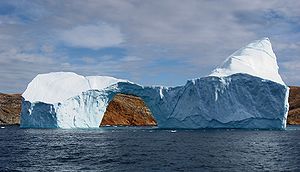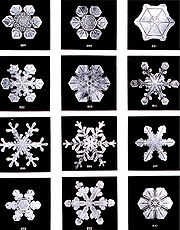Ice, Water, Vapor
- Page ID
- 49945
As a simple example of how the macroscopic properties of a substance can be explained on a microscopic level, consider liquid water. Macroscopically, water at ordinary temperatures is a clear, nearly colorless liquid. Its density is 0.98 g cm–3 at room temperature, as compared with only 0.92 g cm–3 for ice, a fact that must be explained by atomic/molecular theory. If ice were not less dense than water, it would sink, having a devastaing effect on lake bottom ecosystems.

When water is heated, it remains a liquid until quite a high temperature, finally boiling at 100°C to give an invisible vapor. Water vapor behaves much like any other gas. It is easily compressible. Even when quite modest pressures are applied, the volume decreases noticeably. Water vapor is also much less dense than the liquid or the solid. At 100°C and ordinary pressures, its density is 5.98 × 10–4 g cm–3 [2], less than one thousandth that of solid or liquid mercury.
A modern chemist would interpret these macroscopic properties in terms of a microscopic model involving molecules of water. As shown in the following figure, the atoms may be thought of as small, hard spheres. Like billiard balls they can move around and bounce off one another. In solid ice the centers of adjacent molecules are separated by only about 180 pm (1.8 × 10–10 m or 1.8 Å)[3] , but the distance is quite variable because the molecules are arranged in hexagonal arrays, a submicroscopic feature that leads to the observable hexagonal structure of snowflakes.

Although each molecule can move around a little, the others surround it so closely that it cannot escape its allotted position. Hence the solid is rigid. As temperature increases, the molecules vibrate more violently, and eventually the solid melts. In liquid water, the regular, geometrically rigid structure is gone and the atoms are free to move about, but they are still rather close together and difficult to separate. They may form clumps of several molecules with structures similar to the solid. The ability of the molecules to move past each other accounts for the fact that liquid water can flow and take the shape of its container. Note that the structure of the solid is not as compact as that of the liquid; a gaps are present in the ice lattice structure. These gaps explain why ice is less dense than liquid water.
Several websites offer molecular animations of water properties, and change of state and other animations. [5] [6]
In gaseous water, also called water vapor, the molecules are very much farther apart than in the liquid and they move around rapidly with only occasional interactions. Since there are very few molecules per unit volume, the density is considerably lower than for the liquid and solid. By moving rapidly in all directions, the molecules of water (or any other gas for that matter) are able to fill any container in which they are placed. When the molecules hit a wall of the container, they bounce off. This constant bombardment by molecules on the microscopic level accounts for the pressure exerted by the gas on the macroscopic level. The gas can be easily compressed because there is plenty of open space between the molecules. Reducing the volume merely reduces that empty space. The liquid and the solid are not nearly so easy to compress because there is little or no empty space between the molecules.
You may have noticed that although our microscopic model can explain many of the properties of solid, liquid, and gaseous water, it cannot explain all of them. The very faint blue color and the ability to cause clumping (coascervation) of insoluble molecules into cell-like strucures, for example, remain mysterious. There are two approaches to such a situation. We might discard the idea of atoms and molecules in favor of a different theory that can explain more macroscopic properties. On the other hand it may be reasonable to extend the atomic theory so that it can account for more facts. The second approach has been followed by chemists. In the current section on Atoms, Molecules and Chemical Reactions as well as Using Chemical Equations in Calculations we shall discuss in more detail those facts that require only a simple atomic theory for their interpretation. Many of the subsequent sections will describe extensions of the atomic theory that allow interpretations of far more observations.
From ChemPRIME: 2.1: Macroscopic Properties and Microscopic Models
References
- ↑ en.Wikipedia.org/wiki/Water
- ↑ http://hyperphysics.phy-astr.gsu.edu/HBASE/kinetic/watvap.html#c3
- ↑ en.Wikipedia.org/wiki/Hydrogen_bonds
- ↑ en.Wikipedia.org/wiki/Water
- ↑ http://mutuslab.cs.uwindsor.ca/schurko/animations/waterphases/status_water.htm
- ↑ http://chemsense.sri.com/classroom/examples/waterWigglesMAT311.qt
Contributors and Attributions
Ed Vitz (Kutztown University), John W. Moore (UW-Madison), Justin Shorb (Hope College), Xavier Prat-Resina (University of Minnesota Rochester), Tim Wendorff, and Adam Hahn.


